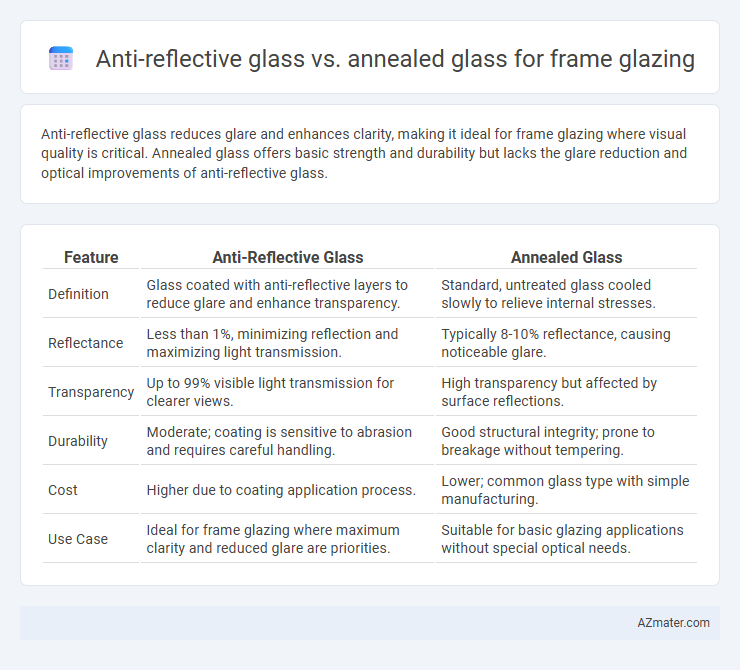Anti-reflective glass reduces glare and enhances clarity, making it ideal for frame glazing where visual quality is critical. Annealed glass offers basic strength and durability but lacks the glare reduction and optical improvements of anti-reflective glass.
Table of Comparison
| Feature | Anti-Reflective Glass | Annealed Glass |
|---|---|---|
| Definition | Glass coated with anti-reflective layers to reduce glare and enhance transparency. | Standard, untreated glass cooled slowly to relieve internal stresses. |
| Reflectance | Less than 1%, minimizing reflection and maximizing light transmission. | Typically 8-10% reflectance, causing noticeable glare. |
| Transparency | Up to 99% visible light transmission for clearer views. | High transparency but affected by surface reflections. |
| Durability | Moderate; coating is sensitive to abrasion and requires careful handling. | Good structural integrity; prone to breakage without tempering. |
| Cost | Higher due to coating application process. | Lower; common glass type with simple manufacturing. |
| Use Case | Ideal for frame glazing where maximum clarity and reduced glare are priorities. | Suitable for basic glazing applications without special optical needs. |
Introduction to Frame Glazing Glass Options
Frame glazing glass options include anti-reflective glass and annealed glass, each serving distinct purposes in architectural design. Anti-reflective glass enhances visual clarity by reducing glare and reflections, making it ideal for display windows and storefronts. Annealed glass, known for its strength and safety, undergoes slow cooling to relieve internal stress, commonly used in standard window frames where durability is essential.
What is Anti-Reflective Glass?
Anti-reflective glass is specially coated to minimize surface reflections, enhancing light transmission and clarity in frame glazing applications. Compared to annealed glass, which is standard unfined glass without special coatings, anti-reflective glass improves visibility and reduces glare, making it ideal for displays, windows, and architectural elements requiring high optical performance. This coating typically involves multiple layers of metal oxides that optimize light passage, improving aesthetics and functionality in various environments.
Key Features of Annealed Glass
Annealed glass is a standard, heat-treated flat glass known for its smooth surface and clarity, offering cost-effective and versatile glazing solutions for frames. It is softer and more prone to breakage compared to tempered or laminated glass but provides excellent workability for cutting, drilling, and shaping during installation. Annealed glass lacks the specialized coatings of anti-reflective glass, resulting in higher reflectivity and less glare reduction.
Visual Clarity Comparison
Anti-reflective glass significantly enhances visual clarity by reducing surface reflections and glare, allowing for a clearer and more true-to-color view compared to annealed glass. Annealed glass, while strong and standard for glazing, tends to reflect more ambient light, which can obscure visibility and cause distractions in high-light environments. In frame glazing applications, choosing anti-reflective glass ensures optimal transparency and improved aesthetic appeal, especially in settings demanding precise visibility and minimal reflection distortions.
Light Transmission and Glare Reduction
Anti-reflective glass for frame glazing offers superior light transmission, typically allowing up to 99% of visible light to pass through, significantly reducing glare and enhancing visual clarity compared to standard glass. Annealed glass generally transmits around 80-90% of light but lacks specialized coatings, resulting in higher glare and reflections that can cause discomfort in brightly lit environments. Choosing anti-reflective glass improves daylight utilization and visual comfort, making it ideal for spaces that require minimal light distortion and maximum natural illumination.
Durability and Safety Considerations
Anti-reflective glass offers enhanced durability with a specialized coating that reduces glare and resist scratches, making it ideal for long-lasting frame glazing applications. Annealed glass, while more affordable, is prone to shattering into large, sharp pieces upon impact, presenting significant safety risks in framing contexts. Safety considerations favor anti-reflective glass due to its improved structural integrity and reduced likelihood of hazardous breakage compared to annealed glass.
Aesthetic Impact on Framed Artwork and Photos
Anti-reflective glass significantly enhances the aesthetic impact of framed artwork and photos by minimizing glare and reflections, ensuring vibrant color accuracy and clear visibility from various angles. Annealed glass, while more affordable, tends to produce noticeable reflections that can obscure details and diminish the viewer's experience. For superior presentation and protection in frame glazing, anti-reflective glass is the preferred choice for preserving the integrity and vibrancy of visual displays.
Cost and Availability
Anti-reflective glass typically incurs higher costs due to its specialized coatings designed to reduce glare and enhance clarity, making it less widely available than annealed glass, especially in standard sizes. Annealed glass is more affordable and readily accessible, commonly used for frame glazing because of its simplicity and widespread manufacturing. For budget-conscious projects requiring standard glazing, annealed glass offers greater availability and cost-effectiveness compared to the premium-priced anti-reflective alternative.
Maintenance and Cleaning Requirements
Anti-reflective glass significantly reduces glare and smudges, making maintenance easier and requiring less frequent cleaning compared to annealed glass. Annealed glass tends to accumulate visible dirt and fingerprints more quickly, demanding regular cleaning with non-abrasive tools to maintain clarity. Both types benefit from gentle cleaning solutions, but anti-reflective coatings can be sensitive to harsh chemicals, necessitating specialized care products.
Choosing the Right Glass for Your Frame
Selecting the right glass for your frame glazing involves comparing anti-reflective glass and annealed glass based on clarity and durability needs. Anti-reflective glass offers superior light transmission and reduces glare, enhancing visual comfort and display visibility, making it ideal for high-end displays and framed artwork. Annealed glass provides basic strength and is cost-effective but lacks the enhanced optical properties of anti-reflective glass, suitable for standard framing where glare reduction is not a priority.

Infographic: Anti-reflective glass vs Annealed glass for Frame glazing
 azmater.com
azmater.com